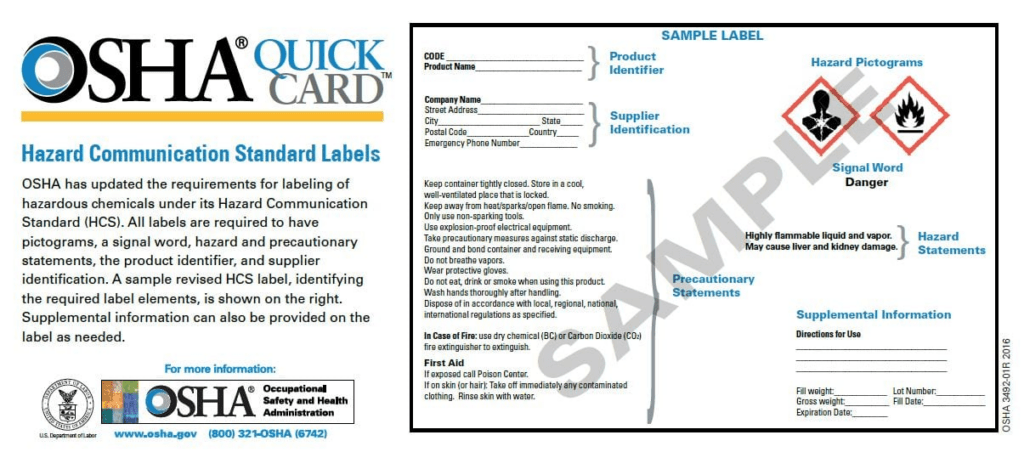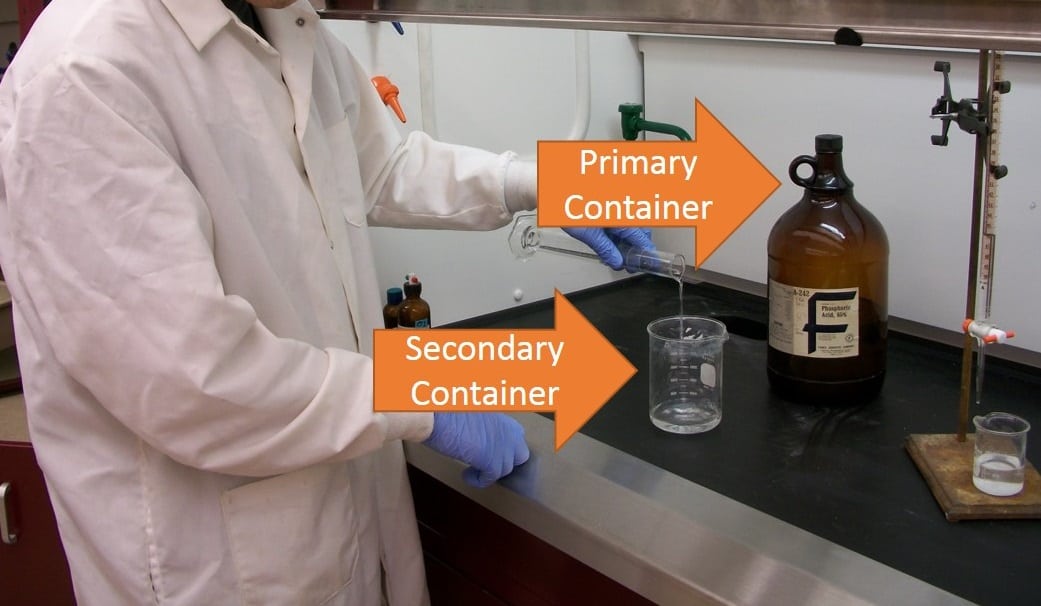
Globally Harmonized System for Hazard Communication (GHS)
Worker’s Right to Know: According to Washington State law, EWU must make sure that all employees are aware of hazardous chemicals in their workplace.
EWU Chemical Hazard Communication Program
This is the EWU program that is used to implement the requirements found in WAC 296-901. It is designed to ensure that employees are informed regarding the potential hazards of the chemicals/materials they work with or near by means of training, labels/signs, and safety data sheets.
Safety Data Sheets (SDS)

A safety data sheet or SDS (formerly known as material safety data sheet or MSDS) is a document provided by chemical manufacturers or suppliers containing information about the chemical or product. It contains general information about the chemical/product and the manufacturer/supplier as well as safety information regarding use and storage and emergency response procedures.
They are required to be provided for every chemical/chemical product purchased. Sometimes they are shipped with the chemical/product and other times they are available on the supplier’s/manufacturer’s website.
Every room on campus that has hazardous chemicals or products must have access to a SDS for each chemical item. The location must be easily identifiable and accessible at all times by anyone in the room.
SDS can be maintained either be hard copies in a binder or electronic copies on a common computer or thumb drive. Internet access must not be required to access the SDS.
How to Read a Safety Data Sheet
Flinn Scientific has a PDF that introduces each section of the new SDS and points out where important information can be located.
For more information about SDS
Visit this OSHA page for more detailed information about the contents of a safety data sheet.
Always read the SDS before working with a new chemical or product.
Chemical Labels
All chemical containers must be labeled with:
- Complete chemical name(s)
- Chemical amount(s) in percentages or molarity
- All hazard warnings
Purchased containers, known as primary containers, will follow the Hazard Communication Standard and provide all the information shown on the OSHA Quick Card below.

Secondary Containers

A secondary containers is any container that a chemical is transferred into.
Secondary containers must be labeled unless the person who did the transferring will remain in physical possession of the container until it is used up.
If a lab class needs to have unknown samples, all the containers must be labeled with a code that will allow the contents to be identified in the event of an emergency. The code should be kept by the professor or lab instructor and a copy should be kept in the department office for reference.
Labels for secondary containers must have:
- The full chemical name(s)
- The concentration (%, molarity, etc)
- The hazard pictograms or words to describe the hazard (flammable, caustic, oxidizer, etc)
Other information from the standard labels can be added but is not required.
For more information about chemical labeling, read the Laboratory Container Labeling guidance document.
NFPA Diamonds

NFPA 704 fire diamonds (NFPA diamonds) are used to communicate chemical hazards. They are part of the Hazard Door Sign.
The diamond was developed by the National Fire Protection Agency and is aimed at alerting fire fighters to hazards they may encounter when entering a building or room.

The NFPA diamond is divided up into three colored sections with numbers and a white section with text.
The colored sections are red, indicating flammability, blue, indicating health hazards, and yellow, indicating chemical reactivity. Each section is given a number between 0 and 4, representing the degree of hazard. A zero is non-hazardous and a four is extremely hazardous.
The white section is used to contain special information that is relevant in a fire situation.
Flammability (Red)
| Degree of Hazard | Health Hazard Description | Quantity Required for Rating on Door Sign |
|---|---|---|
| 0 | No health hazard | |
| 1 | Exposure would cause irritation or minor injury | 5 gallons |
| 2 | Exposure can cause temporary incapacitation or permanent injury | 3 gallons |
| 3 | Exposure can cause serious or permanent injury | 1 gallons |
| 4 | Short exposure can cause death or major injury | 0.5 gallon |
Health Hazard (Blue)
| Degree of Hazard | Reactivity Hazard Description | Quantity Required for Rating on Door Sign |
|---|---|---|
| 0 | Normally stable, even under fire conditions | |
| 1 | Normally stable, can become unstable when heated | 5 gallons |
| 2 | Undergoes violent chemical change when heated | 3 gallons |
| 3 | Capable of detonation or explosive decomposition but require a strong initiating source | 1 gallons |
| 4 | Readily capable of detonation or explosive decomposition under normal conditions | 0.5 gallon |
Reactivity (Yellow)
| Degree of Hazard | Reactivity Hazard Description | Quantity Required for Rating on Door Sign |
|---|---|---|
| 0 | Normally stable, even under fire conditions | |
| 1 | Normally stable, can become unstable when heated | 5 gallons |
| 2 | Undergoes violent chemical change when heated | 3 gallons |
| 3 | Capable of detonation or explosive decomposition but require a strong initiating source | 1 gallons |
| 4 | Readily capable of detonation or explosive decomposition under normal conditions | 0.5 gallon |
Special Notice (White)
There are three hazards that are recognized by the NFPA as needing special attention.
These hazards are listed in the order of importance. If more than one special hazard is present in a room the higher item on the table should be listed first.
| Symbol | Hazard |
|---|---|
| Water reactive, used for materials that react violently or explosively with water | |
| OXY | Oxidizing, used for materials that allows chemicals to burn without an air supply |
| SA | Simple asphyxiant gas, used to identify the presence of argon, helium, krypton, neon, nitrogen, or xenon gas |

